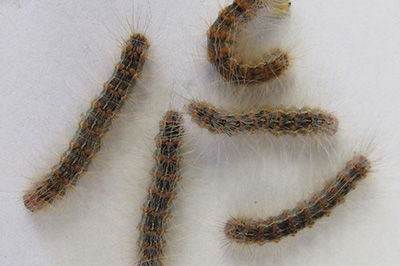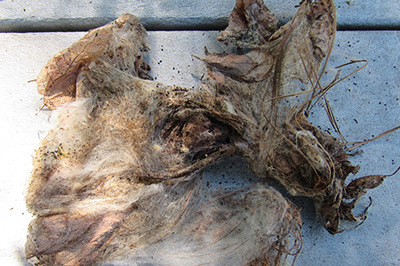Fall Webworms and Eastern Tent Caterpillars
Fall Webworms and Eastern Tent Caterpillars
Oh, What a Web We Weave Once We Hatch to Feed

(Photo courtesy of Jay Sturner)
By Bill Willis
October 11, 2016
Both fall webworms and eastern tent caterpillars develop into moths, spin webs, crawl around in trees, eat leaves, and can cause homeowners despair. Employees have seen webs from both kinds of these caterpillars near the lake and ball field. Despite some similarities, these caterpillars have some important differences.
Eastern tent caterpillars usually appear in North Carolina in the spring. Like their name implies, fall webworms are seen in late summer. The tent caterpillars eat crabapple, hawthorn, and flowering cherry trees. The fall webworm is a less finicky eater; they will eat almost anything with leaves, including more than 120 different species of deciduous trees including crabapple, ash, and sweet gum. In their search for food, the fall webworms may attack the same tree that the tent caterpillars did in the spring.
Control Measures to Prevent Damage to the Landscape

(Photo courtesy of Andy Reago and Chrissy McClarren)
These caterpillars can cause problems for gardeners and homeowners as they ingest vegetation in gardens. Even moths can lead to problems, as they will eventually breed additional caterpillars. It’s important to remove the webs of both types of caterpillars early even if it means manually pulling or cutting the webs out. If left alone, the caterpillars could easily defoliate a small tree before moving on to another tree. This leaf loss will then weaken the tree by reducing the total photosynthesis. The webs act as a barrier to sprays, which is why it’s imperative to, first open up the webs to reach the foliage where the caterpillars may be hiding. The pesticide, Bacillus thuringiensis var. kurstaki (BT commonly sold as Dipel Dust), is a naturally occurring soil bacterium, that will kill caterpillars after they eat sprayed leaves. This substance will not harm birds or animals that might feed on the leaves or caterpillars and is safe around pets and humans.
(Members of Wildlife and Industry Together also contributed to this article).

(Photo courtesy of Bill Willis)

(Photo courtesy of Bill Willis)

(Photo courtesy of Bill Willis)

(Photo courtesy of Bill Willis)

(Photo courtesy of Bill Willis)

(Photo courtesy of Bill Willis)



